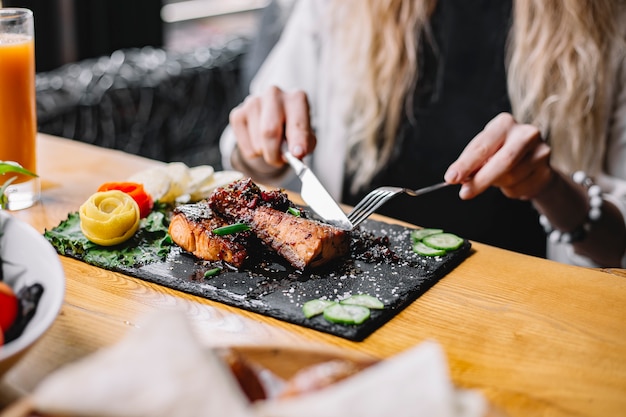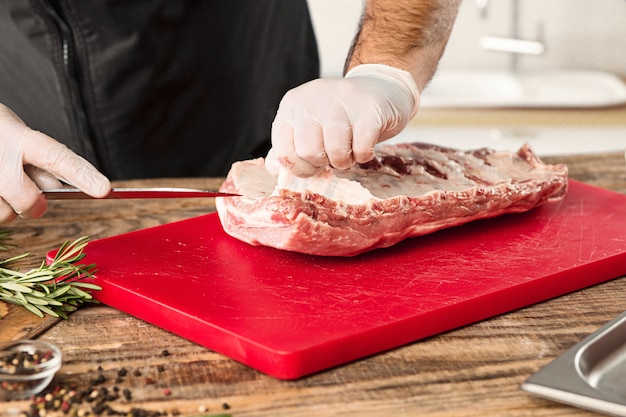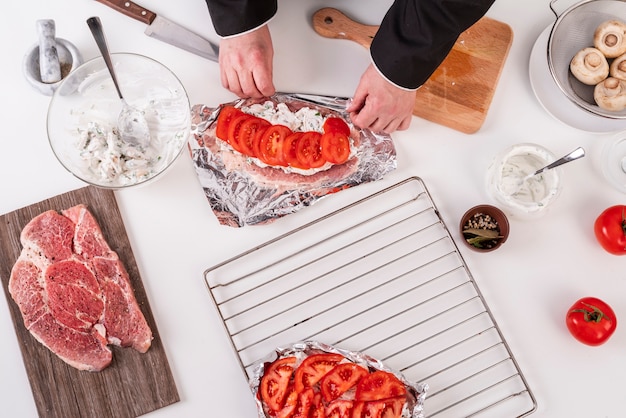Let's be honest, folks, there's nothing quite like a perfectly cooked steak. That juicy, tender, flavorful experience is pure culinary magic. But finding that perfect balance of doneness and flavor can be a bit of a challenge, especially with a cut like sirloin tip. It's a lean, versatile steak, but it can be a bit tough if you're not careful.
Over the years, I've learned a few tricks and secrets to getting that sirloin tip steak just right. And trust me, the journey is worth it! So, grab your apron, sharpen your knives, and join me on this adventure in steak mastery.
(Part 1) Understanding the Beast: The Sirloin Tip Steak

First things first, let's get to know our star ingredient – the sirloin tip steak. It might not be the most glamorous cut, but it's a real workhorse in the kitchen. Its leanness makes it a fantastic choice for those looking for a leaner meal, but it's also where the challenge lies. If you're not careful, it can end up a bit dry and tough. But fear not! With the right approach, you can unlock its full potential and enjoy a truly delicious steak.
The Hidden Gems of the Sirloin Tip
- Flavorful & Rich: Sirloin tip has a distinctly beefy flavor, that deep, savory note that makes you want to savor every bite. It’s a taste that’s hard to resist.
- Versatility is Key: This cut is a chameleon in the kitchen. Whether you're grilling, pan-frying, or even roasting, the sirloin tip can rise to the occasion.
- budget-friendly: Let’s face it, a good sirloin tip is a real value for your money. It allows you to create a delicious meal without breaking the bank.
Choosing the Perfect Cut: A Steak Connoisseur's Guide
Choosing the right sirloin tip steak is crucial. Here's how to pick one that'll give you the best possible results:
- Color is Key: A good sirloin tip should have a vibrant red color with a bit of marbling (those beautiful streaks of white fat) running through it.
- Firm & Springy: Feel the texture. The meat should feel firm and springy to the touch. Avoid anything that feels mushy or slimy.
- Thickness Makes a Difference: Aim for a steak that's at least 1 inch thick. This will give you a nice, even sear and a juicy center.
When in doubt, don’t hesitate to ask your butcher. They’re the experts and can give you great advice on which cuts are fresh and perfect for your needs.
(Part 2) Prepping for Perfection: The Art of Steak Preparation

Alright, you've got your perfect sirloin tip steak. Now it's time to show it some love and prepare it for cooking. This is where my personal experiences come in handy. I've made all the mistakes so you don’t have to!
The Temperature Transformation: Bringing Your Steak to Room Temperature
Here's a tip that’s revolutionized my steak game: bring your steak to room temperature before cooking. It might seem like a tiny detail, but it makes a world of difference.
Imagine you’re taking a steak straight from the fridge and throwing it onto a hot grill. That sudden temperature change can lead to uneven cooking, with the outside getting charred while the inside remains cold. By bringing the steak to room temperature, you allow it to warm up gradually, ensuring a more even and thorough cook.
I typically take my steak out of the fridge about 30 minutes before I start cooking. It’s enough time for it to relax and come up to room temperature, leading to a more tender and flavorful steak.
The Power of Salt: Seasoning Like a Pro
Salt is the king of seasonings when it comes to steak. It's not just about adding flavor; it actually helps draw out moisture and creates that beautiful, crispy crust we all crave. Don’t be shy, season generously on both sides.
Now, here's a personal preference: I like to salt my steak just before cooking. I’ve found that salting too early can sometimes make the meat a bit dry. But hey, you can experiment and see what works best for you.
Beyond Salt: Expanding Your Seasoning Arsenal
While salt reigns supreme, there’s room for other players in the seasoning game. Black pepper is a classic, adding a bit of heat and depth to the flavor. But don’t be afraid to get creative! Some of my favorite additions include:
- Garlic Magic: A few cloves of fresh garlic, minced or smashed, infuse the steak with a beautiful aroma and flavor.
- Herbs for Complexity: Rosemary, thyme, oregano, even a pinch of dried chili flakes – they all add a touch of complexity to the flavor profile.
- Smoky Paprika: A touch of paprika adds a smoky, earthy dimension to the flavor, taking your steak to the next level.
(Part 3) Mastering the Fire: cooking techniques for Sirloin Tip Steak

Now we’re getting to the fun part – the actual cooking! This is where your culinary skills really shine. We’ll explore three popular methods that are sure to bring out the best in your sirloin tip: grilling, pan-frying, and oven-roasting.
1. Grilling: The Classic Choice for Steak Lovers
There’s nothing quite like the smell of a steak grilling over an open fire. It's a quintessential summer experience, evoking memories of barbecues and laughter. But even if you’re a city dweller without a backyard, you can achieve that same smoky flavor with a good quality grill pan.
Prepping the Grill: Setting the Stage for Success
Before you start grilling, make sure your grill is clean and hot. Brush the grates with a bit of oil – this will prevent sticking and ensure a beautiful sear.
Grilling Time: Get that Sizzle
Place your seasoned steak on the hot grill. Let it cook undisturbed for about 3-4 minutes per side, or until you get that perfect, dark sear. This is crucial for creating a flavorful crust that adds depth to the taste.
Flip and Finish: Achieving the Perfect Doneness
Flip the steak and cook for another 2-3 minutes per side, or until it reaches your desired level of doneness. Remember:
- Rare: 125°F (52°C) – Cool red center, warm, soft, and slightly pliable.
- Medium-Rare: 130°F (54°C) – Warm red center, still tender and juicy.
- Medium: 140°F (60°C) – Pink center, firm and flavorful.
- Medium-Well: 150°F (65°C) – Slightly pink center, firm and slightly less juicy.
- Well-Done: 160°F (71°C) – Completely brown, firm, and dry.
Use a meat thermometer to check the internal temperature of your steak for the most accurate results.
2. Pan-Frying: The Kitchen-Friendly Option for steak mastery
Pan-frying is a fantastic alternative if you don't have a grill. It's quick, easy, and can deliver incredible results, making it a perfect choice for busy weeknights.
Heating the Pan: The Key to a Stunning Sear
Get a cast-iron skillet or heavy-bottomed pan nice and hot over medium-high heat. Add a tablespoon or two of oil, and let it heat up until it shimmers. You want the pan to be sizzling hot when you add the steak.
Searing: Achieving that Delightful Crust
Carefully place the steak in the hot pan. Don't overcrowd the pan – this will lower the temperature and prevent a good sear. Let the steak cook undisturbed for about 3-4 minutes per side, or until you get that beautiful, golden-brown crust.
Finishing the Steak: To Tenderness
Reduce the heat to medium-low, and cook for another 2-3 minutes per side, or until the steak reaches your desired level of doneness.
For an extra touch of flavor, try adding a tablespoon or two of butter towards the end of cooking. As the butter melts, baste the steak with it to create a rich, flavorful sauce.
3. Oven-Roasting: The Slow and Steady Method for Even Cooking
If you're looking for a more hands-off approach, oven-roasting is a great choice. It's perfect for larger pieces of sirloin tip and provides a more even cook.
The Right Temperature: Slow and Steady Wins the Race
Preheat your oven to 350°F (175°C). Place your seasoned steak on a baking sheet lined with parchment paper. For an extra burst of flavor, try roasting the steak on a bed of chopped onions and garlic.
Roast Until Perfect: Monitoring for Doneness
Roast the steak for about 15-20 minutes per inch of thickness, or until it reaches your desired level of doneness. Again, use a meat thermometer to check the internal temperature for accuracy.
Resting Time: A Crucial Step for Juiciness
Once the steak is cooked, remove it from the oven and let it rest for 5-10 minutes before slicing and serving. This allows the juices to redistribute throughout the steak, resulting in a more tender and flavorful bite.
(Part 4) Doneness and Beyond: Understanding Your Steak's Temperature
Now, we're getting into the nitty-gritty of steak cooking – doneness. Every steak lover has their own preference, and it's a matter of personal taste. But understanding the different levels of doneness and how to achieve them is essential for creating the perfect steak.
The steak doneness Guide: A Visual and Temperature Guide
Take a look at this table to get a better idea of what each level of doneness looks like and what the corresponding temperature is:
| Doneness | Internal Temperature (°F) | Internal Temperature (°C) | Description |
|---|---|---|---|
| Rare | 125-130 | 52-54 | Cool red center, warm, soft, and slightly pliable. |
| Medium-Rare | 130-135 | 54-57 | Warm red center, still tender and juicy. |
| Medium | 135-140 | 57-60 | Pink center, firm and flavorful. |
| Medium-Well | 140-150 | 60-65 | Slightly pink center, firm and slightly less juicy. |
| Well-Done | 150-160 | 65-71 | Completely brown, firm, and dry. |
I’m a big fan of medium-rare, myself. That beautiful, blushing pink center with its juicy tenderness is truly a treat. But I’ve learned that you can’t force everyone to be a medium-rare convert.
Doneness Mistakes: Avoid Overcooking Your Steak!
Overcooking is a common mistake, and it can ruin a perfectly good steak. It results in a dry, tough steak, and it’s a real shame.
Here are a few key tips to avoid overcooking:
- Don’t Overcook: It's tempting to keep flipping and checking the steak, but try to resist. The more you disturb it, the more you risk overcooking it. Let it cook undisturbed until it reaches your desired level of doneness.
- Trust the Thermometer: A meat thermometer is your best friend. Use it to accurately measure the internal temperature of your steak and ensure it's cooked to your liking.
Resting Time: Letting the Steak Relax
Once your steak is cooked, it's crucial to let it rest for 5-10 minutes before slicing and serving. This gives the juices time to redistribute throughout the steak, resulting in a more tender and flavorful bite.
(Part 5) The Perfect Plate: Presenting Your Steak Masterpiece
You’ve got your perfectly cooked steak, but don't forget about the presentation! It’s not just about the taste; it’s about making the whole experience special.
Choosing the Right Plate: Setting the Stage for a Delicious Experience
A good plate should be the perfect canvas for your steak. I prefer a simple, white plate that lets the steak be the star. Avoid busy patterns or designs that distract from the main event.
The Art of Garnishing: Adding a Touch of Elegance
A few simple garnishes can elevate your steak from ordinary to extraordinary. Here are a few ideas:
- Fresh Herbs: A sprig of rosemary or thyme adds a touch of freshness and flavor.
- Lemon Wedges: A squeeze of lemon juice brightens the flavor and adds a bit of acidity.
- Roasted Vegetables: A few roasted vegetables, like asparagus or Brussels sprouts, make for a balanced and colorful plate.
- Potato Wedges: Crispy, golden potato wedges provide a satisfying contrast to the tender steak.
The Finishing Touch: A Sauce to Savor
A good sauce can really take your steak to the next level. Some classic options include:
- Béarnaise: A rich and creamy sauce made with egg yolks, butter, and tarragon.
- Peppercorn Sauce: A savory sauce made with cracked peppercorns, butter, and red wine.
- Red Wine Sauce: A simple, flavorful sauce made with red wine, shallots, and herbs.
Don't feel limited by tradition. You can create your own unique sauce with your favorite ingredients!
(Part 6) steak sides: Completing the Feast
Your steak is ready, but no meal is complete without the right sides. It’s all about finding those perfect pairings that complement the flavor of the steak.
Classic Combinations: Timeless Tastes
There are some classic combinations that always work. You can’t go wrong with:
- Roasted Potatoes: Crispy on the outside and fluffy on the inside, roasted potatoes are a perfect match for steak.
- green beans: Steamed, sauteed, or roasted, green beans add a bright and refreshing note to the plate.
- Creamed Spinach: A creamy and decadent side that complements the richness of the steak.
Beyond the Basics: Getting Creative with Sides
But let’s be honest, sometimes you want to step outside the box. Here are some more unusual sides that can elevate your steak dinner:
- Grilled Pineapple: A sweet and tangy side that adds a surprising twist to the meal.
- Asparagus with Lemon: A light and refreshing side that complements the richness of the steak.
- Mushroom Risotto: A creamy and earthy side that's perfect for a special occasion.
(Part 7) The Art of Leftovers: Making the Most of Your Steak
Leftover steak? No problem! It's a great opportunity to get creative and turn those leftovers into a delicious new meal.
Steak Sandwiches: A Quick and Easy Solution
One of the easiest ways to use leftover steak is to make sandwiches. Simply slice the steak and put it on a toasted bun with your favorite toppings like cheese, onions, or lettuce.
Steak Salad: A Light and Healthy Option
Leftover steak can also be added to a salad for a satisfying and protein-packed meal. Combine the steak with your favorite greens, vegetables, and a light dressing.
Steak Stir-Fry: A Flavor-Packed Adventure
Slice the leftover steak into thin strips and add it to a stir-fry. Combine it with your favorite vegetables and sauce for a quick and flavorful meal.
Steak Soup: A Comforting and Hearty Dish
Leftover steak can also be used to make a delicious soup. Add the steak to your favorite soup recipe, or create your own unique blend of flavors.
(Part 8) FAQs: Your Steak Questions Answered
Now, let’s dive into those FAQs and address your burning questions about cooking sirloin tip steak.
1. What if my steak is too thick or too thin?
No worries! If your steak is too thick, you can always slice it in half to create two thinner steaks. If your steak is too thin, you can cook it for a shorter time, but be careful not to overcook it.
2. Can I use a different cut of beef instead of sirloin tip?
Absolutely! You can use other cuts of beef, like ribeye, new york strip, or filet mignon. Just be sure to adjust the cooking time based on the thickness of the cut.
3. How do I know if my steak is done without a thermometer?
If you don't have a meat thermometer, you can check the doneness of your steak by pressing on it. A rare steak will be soft and squishy, while a well-done steak will be firm and springy. But, honestly, I wouldn’t recommend relying on this method. A thermometer is much more reliable.
4. What happens if I overcook my steak?
If you overcook your steak, it will be dry and tough. The best way to avoid this is to use a meat thermometer and cook your steak to your desired level of doneness.
5. Can I freeze sirloin tip steak?
Yes, you can freeze sirloin tip steak. Wrap it tightly in plastic wrap and aluminum foil, and place it in the freezer for up to 3 months. When you're ready to cook it, defrost it in the refrigerator overnight.
Well, there you have it! My ultimate guide to cooking sirloin tip steak. I hope you’ve found it helpful and inspiring. Now go forth and conquer those steaks! I know you can do it. And remember, the most important ingredient is a little bit of passion and a whole lot of fun. Happy cooking!
Everyone is watching

Prime Rib Roast Cooking Time Chart: Per Pound Guide
Cooking TipsPrime rib roast. Just the name conjures images of lavish dinners, crackling fires, and hearty laughter. It’s ...

How Long to Bake Potatoes in the Oven (Perfect Every Time)
Cooking TipsBaked potatoes are a staple in my kitchen. They're incredibly versatile, delicious, and surprisingly easy to m...

Perfect Rice Every Time: The Ultimate Guide to Cooking Rice
Cooking TipsAs a self-proclaimed foodie, I've always been a bit obsessed with rice. It's the foundation of countless cuisi...

The Ultimate Guide to Cooking Asparagus: Tips, Techniques, and Recipes
Cooking TipsAsparagus. The mere mention of this spring delicacy conjures up images of vibrant green spears, crisp and burs...

Ultimate Guide to Cooking the Perfect Thanksgiving Turkey
Cooking TipsThanksgiving. Just the word conjures up images of overflowing tables laden with delicious food, the scent of r...
